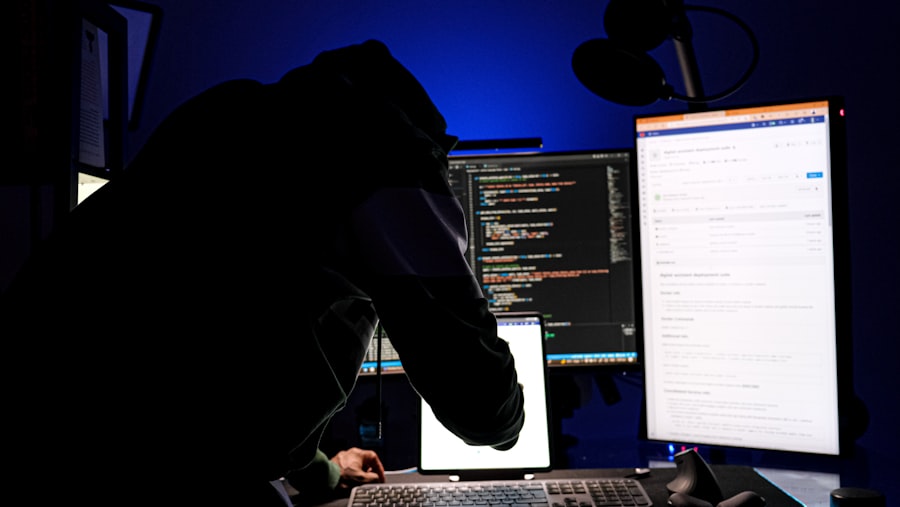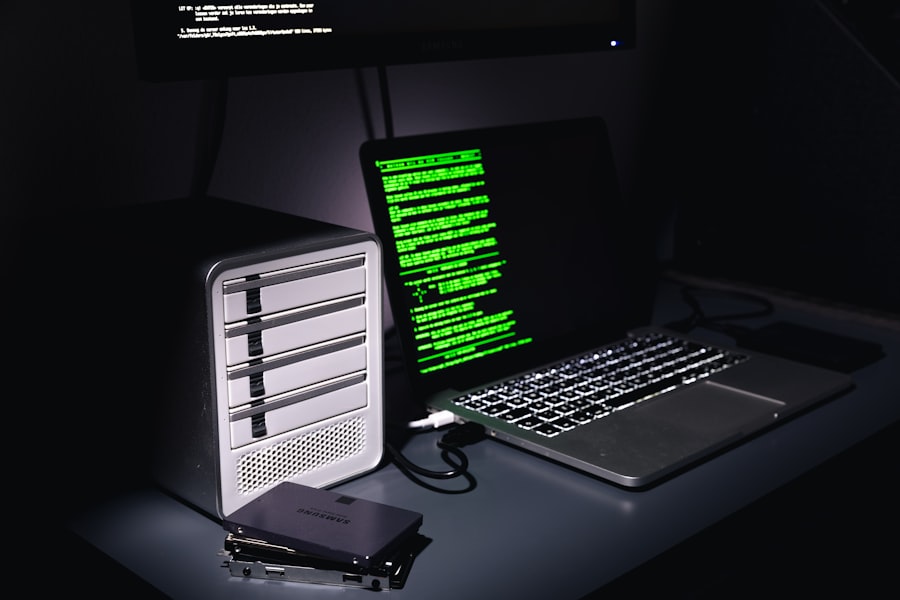In recent years, the intersection of artificial intelligence (AI) and cybersecurity has become a focal point of discussion among professionals and enthusiasts alike. As technology continues to evolve at a breakneck pace, the need for robust cybersecurity measures has never been more critical. You may find yourself wondering how AI fits into this landscape.
The integration of AI into cybersecurity practices is not merely a trend; it represents a fundamental shift in how organizations approach the protection of their digital assets. With the increasing sophistication of cyber threats, AI offers innovative solutions that can enhance security protocols and streamline operations. As you delve deeper into this topic, it becomes evident that AI is not just a tool but a transformative force in the realm of cybersecurity.
It has the potential to redefine traditional roles, automate mundane tasks, and improve threat detection capabilities. However, this evolution also raises questions about the future of cybersecurity careers and the ethical implications of relying on AI systems. Understanding these dynamics is essential for anyone looking to navigate the complexities of cybersecurity in an AI-driven world.
Key Takeaways
- AI is revolutionizing the field of cybersecurity, offering new opportunities and challenges for professionals.
- Traditional cybersecurity roles are being impacted by AI, leading to a shift in job requirements and responsibilities.
- Routine tasks in cybersecurity are being automated with the help of AI, freeing up human professionals to focus on more complex issues.
- AI plays a crucial role in threat detection and response, enabling faster and more accurate identification of potential security breaches.
- AI has the potential to enhance cybersecurity practices by improving efficiency, accuracy, and adaptability in the face of evolving threats.
The Impact of AI on Traditional Cybersecurity Roles
The introduction of AI into cybersecurity has significantly altered traditional roles within the field. You may notice that many cybersecurity professionals are now required to adapt their skill sets to incorporate AI technologies. This shift means that roles once focused solely on manual monitoring and response are evolving to include data analysis, machine learning, and algorithm development.
As a result, you might find that job descriptions are increasingly emphasizing the need for familiarity with AI tools and techniques. Moreover, the integration of AI can lead to a redefinition of responsibilities within cybersecurity teams. For instance, while threat analysts traditionally spent hours sifting through logs and alerts, AI can now assist in identifying patterns and anomalies much faster.
This change allows professionals to focus on higher-level strategic planning and incident response rather than getting bogged down in routine tasks. As you consider a career in this field, it’s crucial to recognize that embracing AI will be essential for staying relevant and effective in your role.
Automation of Routine Tasks in Cybersecurity

One of the most significant advantages of incorporating AI into cybersecurity is its ability to automate routine tasks.
By automating these tasks, cybersecurity teams can allocate their time and resources more effectively, allowing them to focus on complex issues that require human judgment and expertise.
Automation not only increases efficiency but also reduces the likelihood of human error. In a field where mistakes can have dire consequences, relying on AI to manage routine tasks can enhance overall security posture. For example, you might see automated systems that continuously monitor network traffic for suspicious activity, alerting human analysts only when a potential threat is detected.
This proactive approach enables teams to respond more swiftly to incidents while minimizing the risk of oversight.
AI’s Role in Threat Detection and Response
| Metrics | Value |
|---|---|
| Number of threats detected | 150 |
| Response time to threats (in minutes) | 5 |
| Accuracy of threat detection | 98% |
| Reduction in false positives | 50% |
AI’s capabilities in threat detection and response are among its most compelling features. You may be aware that traditional methods often struggle to keep pace with the rapidly evolving tactics employed by cybercriminals. However, AI systems can analyze vast amounts of data in real-time, identifying patterns and anomalies that would be nearly impossible for humans to detect alone.
This ability allows organizations to stay one step ahead of potential threats. Furthermore, AI can enhance incident response by providing actionable insights during a security breach. When an attack occurs, you might find that AI-driven tools can quickly assess the situation, determine the nature of the threat, and recommend appropriate countermeasures.
This rapid response capability is crucial in minimizing damage and restoring normal operations. As you explore the role of AI in cybersecurity, it becomes clear that its contributions to threat detection and response are invaluable in today’s digital landscape.
The Potential for AI to Enhance Cybersecurity Practices
The potential for AI to enhance cybersecurity practices extends beyond mere automation and threat detection. You may discover that AI can also facilitate more sophisticated risk assessments and vulnerability management strategies. By analyzing historical data and current trends, AI systems can help organizations identify their most significant vulnerabilities and prioritize remediation efforts accordingly.
Additionally, AI can support continuous learning within cybersecurity frameworks. As new threats emerge, machine learning algorithms can adapt and improve their detection capabilities over time. This dynamic approach ensures that security measures remain effective against evolving threats.
As you consider the broader implications of AI in cybersecurity, it’s essential to recognize its role in fostering a proactive security culture that emphasizes adaptability and resilience.
The Evolution of Cybersecurity Job Requirements in the Age of AI

As AI continues to reshape the cybersecurity landscape, job requirements are evolving accordingly. You may notice that employers are increasingly seeking candidates with a blend of technical skills and an understanding of AI technologies. Proficiency in programming languages such as Python or R, along with knowledge of machine learning algorithms, is becoming more desirable in job applicants.
Moreover, soft skills are gaining importance as well.
As you prepare for a career in this field, consider how you can develop both your technical acumen and interpersonal skills to meet the demands of an evolving job market.
The Future of Cybersecurity Careers in a World of AI
Looking ahead, the future of cybersecurity careers appears promising yet challenging in a world increasingly influenced by AI technologies. You may find that while some traditional roles may diminish due to automation, new opportunities will arise as organizations seek professionals who can harness the power of AI effectively. Positions focused on developing and managing AI-driven security solutions will likely become more prevalent.
Additionally, as cyber threats continue to grow in complexity, there will be an increasing demand for experts who can interpret AI-generated insights and make informed decisions based on them. This trend suggests that your ability to bridge the gap between technology and strategy will be invaluable in shaping your career trajectory within cybersecurity.
The Ethical and Privacy Implications of AI in Cybersecurity
While the benefits of integrating AI into cybersecurity are substantial, it’s essential to consider the ethical and privacy implications that accompany this technology. You may be aware that the use of AI raises concerns about data privacy, surveillance, and potential biases embedded within algorithms. As organizations deploy AI systems to monitor user behavior or analyze personal data for security purposes, questions arise about consent and transparency.
Moreover, there is a risk that reliance on AI could lead to overconfidence in automated systems, potentially resulting in complacency among human analysts. As you navigate this landscape, it’s crucial to advocate for ethical practices that prioritize user privacy while leveraging the advantages of AI technology. Understanding these implications will not only enhance your credibility as a cybersecurity professional but also contribute to building trust within organizations and among users.
The Need for Human Expertise in Cybersecurity
Despite the advancements brought about by AI, the need for human expertise in cybersecurity remains paramount. You may recognize that while AI can process vast amounts of data quickly, it lacks the nuanced understanding and critical thinking skills that humans possess. Complex decision-making scenarios often require human judgment, particularly when assessing the context surrounding a potential threat or incident.
Furthermore, human analysts play a vital role in interpreting AI-generated insights and translating them into actionable strategies. As you consider your place within this field, remember that your unique perspective and problem-solving abilities will always be essential components of effective cybersecurity practices.
Training and Education for a Career in AI-Enhanced Cybersecurity
To thrive in an increasingly AI-enhanced cybersecurity landscape, investing in training and education is crucial. You may want to explore formal degree programs or certifications that focus on both cybersecurity fundamentals and emerging technologies like machine learning and data analytics. Many institutions now offer specialized courses designed to equip you with the skills needed to navigate this evolving field successfully.
Additionally, staying informed about industry trends through workshops, webinars, and online resources will help you remain competitive in your career pursuits. Engaging with professional networks or communities focused on cybersecurity can also provide valuable insights into best practices and emerging technologies. As you embark on your journey toward a career in this domain, prioritize continuous learning as a means of adapting to the ever-changing landscape.
Balancing AI and Human Expertise in Cybersecurity
In conclusion, the integration of AI into cybersecurity presents both opportunities and challenges that require careful consideration. As you reflect on this dynamic relationship between technology and human expertise, it becomes clear that striking a balance is essential for effective security practices. While AI offers powerful tools for automation, threat detection, and risk assessment, it cannot replace the critical thinking and contextual understanding that only humans can provide.
As you navigate your career path within this field, embrace the potential of AI while recognizing the irreplaceable value of human insight and expertise. By fostering collaboration between technology and human professionals, you can contribute to building resilient cybersecurity frameworks capable of addressing today’s complex challenges while preparing for future threats. Ultimately, your ability to adapt and grow alongside these advancements will define your success in an ever-evolving landscape.
The rapid advancement of artificial intelligence (AI) has sparked discussions about its potential impact on various industries, including cybersecurity. As AI technologies become more sophisticated, there is growing concern about whether they will replace human jobs in cybersecurity. An interesting perspective on this topic can be found in an article on
